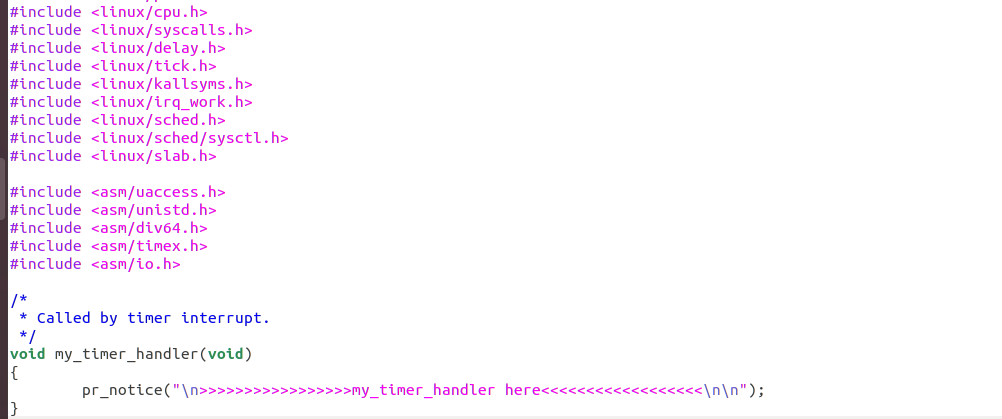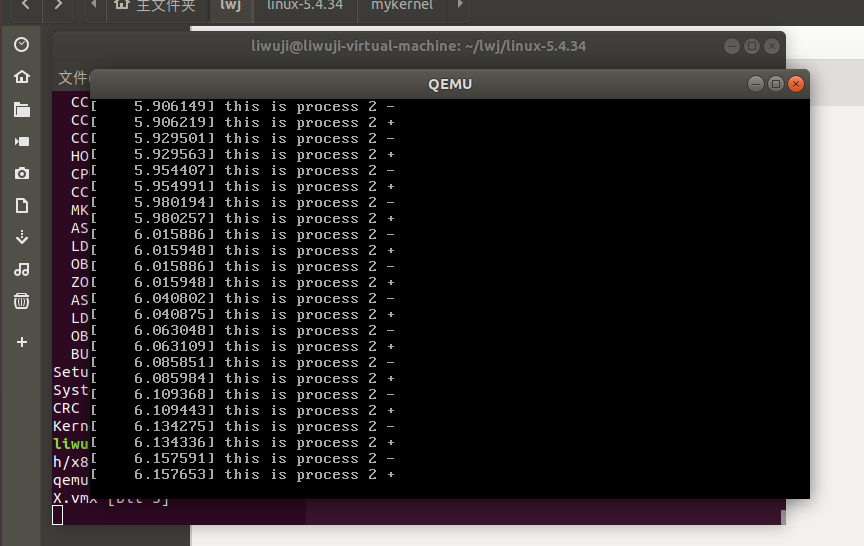实验要求
- 按照https://github.com/mengning/mykernel 的说明配置mykernel 2.0,熟悉Linux内核的编译;
- 基于mykernel 2.0编写一个操作系统内核,参照https://github.com/mengning/mykernel 提供的范例代码;
- 简要分析操作系统内核核心功能及运行工作机制;
实验环境搭建
本次实验使用虚拟机Vmware15,Ubuntu18.01操作系统。
按照如下命令依次执行:
wget https://raw.github.com/mengning/mykernel/master/mykernel-2.0_for_linux-5.4.34.patch sudo apt install axel axel -n 20 https://mirrors.edge.kernel.org/pub/linux/kernel/v5.x/linux-5.4.34.tar.xz xz -d linux-5.4.34.tar.xz tar -xvf linux-5.4.34.tar cd linux-5.4.34 patch -p1 < ../mykernel-2.0_for_linux-5.4.34.patch sudo apt install build-essential gcc-multilib libncurses5-dev bison flex libssl-dev libelf-dev sudo apt install qemu make defconfig make -j$(nproc)
在下载mykernel-2.0_for_linux-5.4.34.patch时可能出现无法连接或者拒绝访问的情况,可以修改hosts文件,具体参照这篇博文https://www.cnblogs.com/sinferwu/p/12726833.html。
执行到这里环境基本搭建成功,然后可以启动mykernel进行验证,执行以下代码
qemu-system-x86_64 -kernel arch/x86/boot/bzImage
然后出现如下界面:

可以看到qemu在不停执行,具体我们可以看一下代码:


可以看出mymain.c中的代码在不停地执⾏。同时有⼀个中断处理程序的上下⽂环境,周期性地产⽣的时钟中断信号,能够触发myinterrupt.c中的代码。
基于mykernel 2.0编写一个操作系统内核
在https://github.com/mengning/mykernel网址下载孟宁老师的源码,然后将mypcb.h,myinterrupt.c和mymain.c这三个文件拷贝到mykernel目录下,即要覆盖之前的mykernel文件夹下mymain.c和myinterrupt.c,并新增头文件mypcb.h。
mypcb.h定义进程控制块
/* * linux/mykernel/mypcb.h * * Kernel internal PCB types * * Copyright (C) 2013 Mengning * */ #define MAX_TASK_NUM 4 #define KERNEL_STACK_SIZE 1024*2 /* CPU-specific state of this task */ struct Thread { unsigned long ip; unsigned long sp; }; typedef struct PCB{ int pid; volatile long state; /* -1 unrunnable, 0 runnable, >0 stopped */ unsigned long stack[KERNEL_STACK_SIZE]; /* CPU-specific state of this task */ struct Thread thread; unsigned long task_entry; struct PCB *next; }tPCB; void my_schedule(void);
pid:进程号
state:进程状态,在模拟系统中,所有进程控制块信息都会被创建出来,其初始化值就是-1,如果被调度运行起来,其值就会变成0
stack:进程使用的堆栈
thread:当前正在执行的线程信息
task_entry:进程入口函数
next:指向下一个PCB,模拟系统中所有的PCB是以链表的形式组织起来的。
mymain.c:初始化各个进程并启动0号进程
/* * linux/mykernel/mymain.c * * Kernel internal my_start_kernel * Change IA32 to x86-64 arch, 2020/4/26 * * Copyright (C) 2013, 2020 Mengning * */ #include <linux/types.h> #include <linux/string.h> #include <linux/ctype.h> #include <linux/tty.h> #include <linux/vmalloc.h> #include "mypcb.h" tPCB task[MAX_TASK_NUM]; tPCB * my_current_task = NULL; volatile int my_need_sched = 0; void my_process(void); void __init my_start_kernel(void) { int pid = 0; int i; /* Initialize process 0*/ task[pid].pid = pid; task[pid].state = 0;/* -1 unrunnable, 0 runnable, >0 stopped */ task[pid].task_entry = task[pid].thread.ip = (unsigned long)my_process; task[pid].thread.sp = (unsigned long)&task[pid].stack[KERNEL_STACK_SIZE-1]; task[pid].next = &task[pid]; /*fork more process */ for(i=1;i<MAX_TASK_NUM;i++) { memcpy(&task[i],&task[0],sizeof(tPCB)); task[i].pid = i; task[i].thread.sp = (unsigned long)(&task[i].stack[KERNEL_STACK_SIZE-1]); task[i].next = task[i-1].next; task[i-1].next = &task[i]; } /* start process 0 by task[0] */ pid = 0; my_current_task = &task[pid]; asm volatile( "movq %1,%%rsp " /* set task[pid].thread.sp to rsp */ "pushq %1 " /* push rbp */ "pushq %0 " /* push task[pid].thread.ip */ "ret " /* pop task[pid].thread.ip to rip */ : : "c" (task[pid].thread.ip),"d" (task[pid].thread.sp) /* input c or d mean %ecx/%edx*/ ); } int i = 0; void my_process(void) { while(1) { i++; if(i%10000000 == 0) { printk(KERN_NOTICE "this is process %d - ",my_current_task->pid); if(my_need_sched == 1) { my_need_sched = 0; my_schedule(); } printk(KERN_NOTICE "this is process %d + ",my_current_task->pid); } } }
对mymain.c中的my_start_kernel函数进行修改,并在mymain.c中实现了my_process函数,用来作为进程的代码模拟一个个进程,时间片轮转调度。
myinterrupt.c:时钟中断处理和进程调度算法
/* * linux/mykernel/myinterrupt.c * * Kernel internal my_timer_handler * Change IA32 to x86-64 arch, 2020/4/26 * * Copyright (C) 2013, 2020 Mengning * */ #include <linux/types.h> #include <linux/string.h> #include <linux/ctype.h> #include <linux/tty.h> #include <linux/vmalloc.h> #include "mypcb.h" extern tPCB task[MAX_TASK_NUM]; extern tPCB * my_current_task; extern volatile int my_need_sched; volatile int time_count = 0; /* * Called by timer interrupt. * it runs in the name of current running process, * so it use kernel stack of current running process */ void my_timer_handler(void) { if(time_count%1000 == 0 && my_need_sched != 1) { printk(KERN_NOTICE ">>>my_timer_handler here<<< "); my_need_sched = 1; } time_count ++ ; return; } void my_schedule(void) { tPCB * next; tPCB * prev; if(my_current_task == NULL || my_current_task->next == NULL) { return; } printk(KERN_NOTICE ">>>my_schedule<<< "); /* schedule */ next = my_current_task->next; prev = my_current_task; if(next->state == 0)/* -1 unrunnable, 0 runnable, >0 stopped */ { my_current_task = next; printk(KERN_NOTICE ">>>switch %d to %d<<< ",prev->pid,next->pid); /* switch to next process */ asm volatile( "pushq %%rbp " /* save rbp of prev */ "movq %%rsp,%0 " /* save rsp of prev */ "movq %2,%%rsp " /* restore rsp of next */ "movq $1f,%1 " /* save rip of prev */ "pushq %3 " "ret " /* restore rip of next */ "1: " /* next process start here */ "popq %%rbp " : "=m" (prev->thread.sp),"=m" (prev->thread.ip) : "m" (next->thread.sp),"m" (next->thread.ip) ); } return; }
mykernel提供了时钟中断机制,周期性执行my_time_handler中断处理程序。
最后重新编译,在linux-5.4.34目录下执行如下命令:
make defconfig make -j$(nproc) qemu-system-x86_64 -kernel arch/x86/boot/bzImage

可以看到效果:

从process0到process3交替执行
实验总结
通过本次实验,我对操作系统的时间轮转机制和中断机制有了更深的了解,对底层的实现有了更加清晰的认识,实在获益良多。